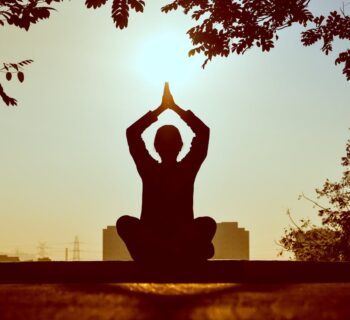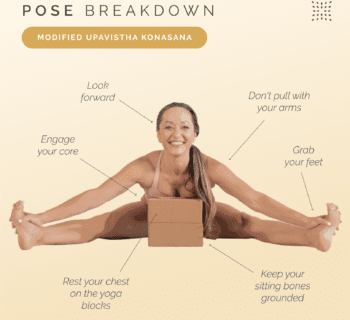Are you having problems with your shoulders? Are you looking for exercises you could do to prevent possible shoulder issues? Shoulder injury can cause limited ranges of motion, including adduction, abduction, and internal and external rotation. Shoulder mobility exercises can prevent scapular pain and thoracic pain. These exercises contribute to your overall strength and flexibility and play a vital role in preventing injuries and promoting proper alignment. Combined with techniques like acupressure and the use of a foam roller, these shoulder mobility exercises boost your range of motion and help you feel better. Whether you’re a beginner or have some experience with yoga, we’ll guide you through a series of shoulder-focused poses and movements designed to increase your range of motion, release tension, and foster a sense of freedom in your upper body. So, get ready to expand your awareness, embrace your body’s innate wisdom, and embark on a journey towards greater shoulder mobility through the transformative power of yoga. This post contains descriptions of yoga poses and shoulder-focused video lessons.
What are the benefits of shoulder mobility exercises?
Shoulder mobility exercises offer a multitude of benefits for individuals who are just starting to learn yoga. These exercises focus on improving the range of motion and strength of the shoulder joints, which are essential for performing various yoga poses effectively and safely. Here are some of the key benefits of incorporating shoulder mobility exercises into your yoga practice:
1. Increased flexibility: Regular shoulder mobility exercises help to increase the flexibility of the shoulder joints, allowing for a greater range of motion. This increased flexibility allows you to perform yoga poses that require overhead reaching, such as downward-facing dog or handstand, with greater ease and comfort.
2. Improved posture: Shoulder mobility exercises target the muscles that support proper posture, such as the upper back and shoulder girdle muscles. By strengthening and lengthening these muscles, you can enhance your overall posture, which not only improves your appearance but also helps to prevent common postural issues and related discomfort.
3. Enhanced stability and balance: Strong and mobile shoulders are crucial for maintaining stability and balance during yoga practice. By engaging in shoulder mobility exercises, you develop better control over your shoulder joints, which enables you to hold yoga poses more effectively and with greater steadiness. This increased stability and balance can also extend to other areas of your life, improving your overall coordination and physical performance.
4. Prevention of injuries: Shoulder mobility exercises can help prevent common shoulder injuries that may occur during yoga practice. These exercises strengthen the muscles and ligaments surrounding the shoulder joints, providing better support and stability. By strengthening these muscles, you reduce the risk of strain or overuse injuries, such as rotator cuff tears or shoulder impingement.
5. Relieves tension and stress: Many people carry tension and stress in their shoulders, leading to stiffness and discomfort. Shoulder mobility exercises can help alleviate this tension and stress, promoting relaxation and a sense of well-being. By releasing tight muscles and improving blood flow to the area, these exercises can provide relief from shoulder pain and stiffness.
How do strength and flexibility contribute to shoulder mobility?
Strength and flexibility are two key factors that contribute to shoulder mobility.
Strength is important because it helps to stabilize and support the shoulder joints. Strong muscles around the shoulders, such as the rotator cuff muscles and the muscles of the upper back, help to keep the shoulder joints in proper alignment and prevent excessive movement or instability. When the muscles are strong, they can better handle the demands of yoga poses that require shoulder mobility, allowing you to move in a controlled and stable manner.
Flexibility, on the other hand, is crucial for achieving a greater range of motion in the shoulder joints. Flexible muscles and tendons allow the joints to move freely and without restriction. When the muscles and tendons are tight or stiff, they can limit the range of motion in the shoulders, making it difficult to perform certain yoga poses that require overhead reaching or rotation of the shoulders. By improving flexibility through regular shoulder mobility exercises, you can increase the range of motion in the shoulder joints and enhance your ability to move with ease in your yoga practice.
Both strength and flexibility work together to create optimal shoulder mobility. Strong muscles provide stability and support, while flexible muscles and tendons allow for a greater range of motion. As you continue to practice shoulder mobility exercises and strengthen and stretch the muscles around the shoulders, you will gradually improve both your strength and flexibility, leading to improved shoulder mobility overall.
Which specific muscles are involved in shoulder mobility?
Several specific muscles are involved in shoulder mobility. These include:
1. Deltoids: The deltoids are the main muscles that make up the shoulders. They are responsible for lifting and rotating the arms and providing stability to the shoulder joints.
2. Rotator cuff muscles: The rotator cuff is a group of muscles that surround the shoulder joint and help to stabilize and rotate the shoulder. The rotator cuff muscles include the supraspinatus, infraspinatus, teres minor, and subscapularis.
3. Trapezius: The trapezius muscle is located in the upper back and neck area and plays a crucial role in shoulder mobility. It helps to elevate and retract the shoulder blades, allowing for proper movement and stability.
4. Rhomboids: The rhomboid muscles are located between the shoulder blades and help to retract and stabilize the scapulae. They are involved in movements such as pulling the shoulders back and down.
5. Pectoralis major and minor: The pectoralis muscles are located in the chest area and play a role in shoulder mobility by allowing for forward and inward movement of the arms.
6. Latissimus dorsi: The latissimus dorsi, also known as the “lats,” are large muscles located in the back. They help with shoulder extension and adduction, allowing for a greater range of motion in the shoulders.
These are just a few of the many muscles involved in shoulder mobility.
What are some effective shoulder mobility exercises?
1. Shoulder circles: Stand tall with your feet hip-width apart. Extend your arms out to the sides, parallel to the floor. Begin to make small circles with your shoulders, gradually increasing the size of the circles. Repeat for 10-15 circles in each direction.
2. Thread the needle pose: Start on all fours in a tabletop position. Reach your right arm under your left arm, threading it through the space between your left arm and leg. Rest your right shoulder and ear on the mat. Hold for 3-5 breaths and then switch sides.
3. Cow face arms: Sit tall with your legs crossed. Reach your right arm straight up towards the ceiling, then bend your elbow and reach your right hand behind your head. With your left arm, reach behind your back and try to clasp your right hand. If you cannot reach, hold onto a strap or towel. Hold for 3-5 breaths and then switch sides.
4. Child’s pose with shoulder stretch: Start on all fours in a tabletop position. Slowly sit back onto your heels, keeping your arms extended in front of you. Walk your hands forward as far as you can while keeping your hips resting on your heels. Feel the stretch in your shoulders and upper back. Hold for 3-5 breaths.
5. Resistance band exercises: Using a resistance band, you can perform exercises such as external rotations and band pull-aparts to strengthen the muscles involved in shoulder mobility. These exercises help to improve stability and flexibility in the shoulders.
6. Wall angels: Stand with your back against a wall and your feet about six inches away from the wall. Raise your arms to shoulder height, with your elbows bent at 90 degrees. Slowly slide your arms up the wall, keeping your back and arms in contact with the wall at all times. Slide your arms back down to the starting position. Repeat for 10-15 reps.
Remember to always listen to your body and not push yourself too hard. If you experience any pain or discomfort during these exercises, stop and consult a healthcare professional.
Are there any risk factors associated with shoulder mobility exercises?
1. Lack of Warm-up:
Engaging in shoulder mobility exercises without properly warming up can increase the risk of injury. Before starting any exercise, it is essential to warm up your body to increase blood flow and prepare your muscles for the upcoming movements. Incorporate dynamic stretches, such as arm circles or shoulder rolls, to warm up the shoulder joints and surrounding muscles.
2. Overexertion and Overstretching:
Pushing yourself too hard or overstretching during shoulder mobility exercises can lead to strains, sprains, or even dislocations. Beginners should focus on gradually building strength and flexibility in their shoulders and upper body. It is crucial to listen to your body and avoid forcing any movements beyond your comfort level. Remember, progress takes time, and it’s better to start slow and steady.
3. Improper Form and Technique:
Performing shoulder mobility exercises with incorrect form and technique can put unnecessary strain on the joints, tendons, and muscles, increasing the risk of injury. Proper alignment is key to avoiding injury and maximizing the benefits of shoulder mobility exercises. It is essential to learn the correct form and technique from a qualified instructor or professional before attempting these exercises on your own. Focus on maintaining proper posture, activating the correct muscles, and moving smoothly and controlled throughout each exercise.
4. Previous Injuries or Conditions:
If you have a history of shoulder injuries or any underlying shoulder conditions, it is important to consult with a healthcare professional before engaging in shoulder mobility exercises. They can provide personalized guidance and recommend modifications or alternative exercises to ensure your safety and prevent further damage.
5. Lack of Progression:
Progressing too quickly or attempting advanced shoulder mobility exercises before mastering the basics can increase the risk of injury. It is vital to start with foundational exercises and gradually increase the intensity or difficulty level as your strength and flexibility improve. This gradual progression allows your body to adapt and ensures that you are ready for more challenging movements.
Incorporating shoulder mobility exercises into your yoga practice can help improve your overall range of motion and prevent injuries. Make sure to warm up properly before performing these exercises and always practice with proper form and technique.
By regularly incorporating these exercises into your routine, you can increase your shoulder mobility and enhance your yoga practice.
Are you looking for more guidance on your yoga journey? Sign up for Omstars to get access to thousands of yoga classes in the comfort of your own home. Click here to start your subscription.
Image by Scott Webb from Pixabay










